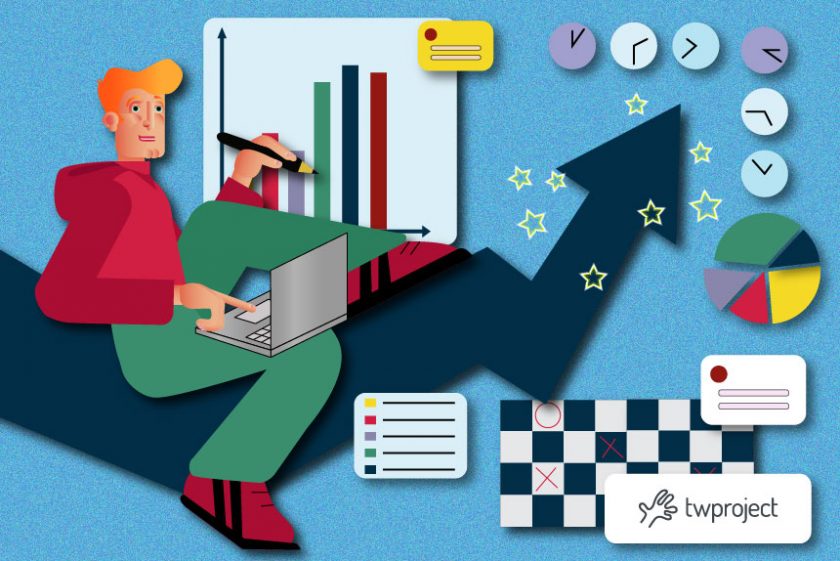What is a project management plan? You probably already know it, but if this is not the case, or if you still have doubts, read this article and we will try to explain it.
Contracts have been signed, handshakes have taken place and a new project is officially on its way.
TABLE OF CONTENTS
But when it comes to planning a new project, a project manager might not know exactly where to start. This is where the project management plan comes into play.
But what is a project management plan? How do you accurately predict the duration of activities? How are the expectations of stakeholders translated into concrete outputs? What happens if something goes wrong?
The project management plan is the answer to these questions and the key to a successful project.
What is a project management plan?
The project manager creates the project management plan based on the input of the project team and the main stakeholders.
A project management plan is an approved formal document that defines how the project will be executed, monitored, and controlled.
It can be a summary or a detailed document and can include baselines, communication plans, subsidiary management plans and other planning documents.
As work progresses, project performance is measured and compared to the base included in the project management plan.
If, while the work progresses, a deviation from the baseline occurs, the project manager will take care of it by making the necessary corrections.
If these corrections fail to correct deviations, formal modification requests to the baselines become necessary.
What are the components of a project management plan?
A project plan is composed of three basic elements:
- Activity: status of the activity, priority, time, allocation of human and financial resources, notifications, etc.
- Tasks: the smallest jobs that make up the largest project.
- Resources: what you need – people, equipment, site, etc. – to complete the tasks of the project.
Obviously, these are the indispensable macro elements that have to be taken into account, but starting to go into detail we can see how the plan must consider other countless aspects.
Among the first elements to consider when planning a project are defining objectives, dividing up the work and establishing a timeline for activities.
It is at this stage that the project manager begins planning activities, a detailed process that identifies each individual task, links it to the necessary resources and assigns a specific deadline.
A key part of the plan is the creation of a Gantt chart, a visual tool that shows the entire schedule of activities, including dependencies between them. This helps the team understand the workflow and clearly visualise the planning, execution and closure phases.
Alongside scheduling, another essential component is risk management. Every project involves uncertainty, and the project management plan must provide for alternative scenarios, contingency plans and strategies to mitigate negative impacts. Anticipating and preparing for potential critical issues is key to maintaining control of the project.
The communication plan should not be overlooked either, as it establishes how information will be shared among team members, stakeholders and any external parties.
Clear, continuous and structured communication is essential to ensure that all parties involved are aligned on objectives, deadlines and responsibilities.
The first step in building an effective plan is therefore to gather all available information, involve key stakeholders and define the expected deliverables in detail. Only then will it be possible to coordinate all components in a coherent manner and confidently aim for the final result.
The details of a Project Management Plan
This is why a project management plan is further divided into many parts, each of which will be elaborated in detail and will be decisive for the success of the project. Let’s see what:
- Determine the scope of the project: establish the limits of the project and the responsibilities of each team member. This is established by determining and documenting specific project goals, results, characteristics, functions, tasks, deadlines and costs.
- Project phases: this is the life cycle, from initiation, planning and execution, to monitoring, control and, finally, project closure. So, here you are breaking a project’s schedule into smaller, more manageable parts. It is possible to think of these as mini-projects that can be marked by milestones.
- Activity planning: this is basically a list of things to do to complete the project. It is here that all that concerns the flow of the project is collected from the beginning to the end.
- Identify the key points of the activities: those activities that signal the end of a phase of the project are called milestones. These milestones are generally indicated in the plan with diamond-shaped icons and help to break down the project into smaller, more manageable pieces.
- Tasks: these jobs should be small incremental steps towards the final output. They can be extracted directly from the program of activities that was created in the previous step.
- Duration: here the project manager calculates how much time he thinks that each activity and project phase will require. These are estimates, but are based on the general deadline of the project and the project manager must still be realistic about them.
- Dependencies: here we talk about the activities that depend on the completion of other activities; before the previous ones are not completed, the next cannot begin. It is possible to link these dependencies and set notifications so that the team knows when they are complete, so as not to block the work and make the process more fluid.
- Resources: they are what is needed to carry out the project. These can be anything, from the people in the project team to the material management software they will need to complete their tasks, from the workplace to external suppliers and contractors, etc.
- Timeline: it is the determination of how much time is available for each phase of the project. A timeline provides a view of the schedule and activities that lets the project manager know how to distribute the workload.
- Budget: here the costs involved in assigning all the resources needed are determined. This number will generally have to be approved by the directors of the organization and / or by the project sponsor and normally lies within a number range; it is therefore necessary to be realistic when making estimates.
- Monitor progress: clearly during the project, the project manager will have to keep track of the progress of the project plan. The actual progress compared to the planned one must be monitored, if possible, in real time, which allows changes to be made in the event of problems before they become unmanageable.
Clearly, at the end of a project, it is important to analyze the entire progress of the project from beginning to end, especially in the case of problems encountered during the life cycle.
It will also be necessary to compare the results obtained with the forecast results included in the project management plan. You will have to reflect on any mistakes you have made, to ensure that the next similar project does not fall into the same mistakes.
Creation of the project plan and support tools
As we could see a project plan includes many elements that have to be considered. This is why project management tools can make the creation of the project plan and its management much simpler and more efficient.
The market offers several project management tools, each with its own features and its own unique graphics.

A Project Management software such as Twproject, for example, stands out for its ability to adapt to both agile projects and more traditional structures, offering an interface that is both intuitive and powerful.
With Twproject, you can:
- Share the project management plan in real time with all users involved;
- Monitor the workload of the team and assign tasks in a balanced way;
- Easily generate a dynamic and updatable Gantt chart;
- Activate automatic notifications in case of changes or upcoming deadlines;
- Keep costs and resources under control with detailed reports;
- Manage critical issues and improve risk management with visual dashboards and smart alerts.
Team members can use Twproject to update their activities, add comments, report problems and actively collaborate. This means getting updated real-time data on the project that will allow the project manager to manage it more productively.
The project management plan is practically a process of organizing the various small pieces in order to achieve the final goal outlined in the project.
You can have a good plan, but a project manager also needs the right tools to implement it correctly, especially in the case of more complex projects.
Even more so in the case of changes to the project management plan, PM tools can be particularly useful.
If you have never used Twproject you can try it for free by clicking here in order to evaluate all its features.
Conclusions
Although the project management plan is developed as part of the project, it should be a living document that evolves as the project progresses and is updated with the most recent relevant information.
This project management plan should be available to all project members, as it can provide essential information about the project itself. We are indeed talking about the main communication document for the project.
Creating a complete and strategically valid plan is essential to ensure the success of a project. Our guidelines can help you a lot in the making and creating it and this might not be as difficult as you think.
In an increasingly dynamic and competitive environment, having software that supports you at every stage of planning, execution and control means reducing errors, improving response times and increasing the likelihood of delivering the project on time, on budget and to the required quality standards.
In short, with a well-designed project management plan, the project manager will have a high probability of keeping the project on track and of fulfilling the promises initially made to the different stakeholders.




